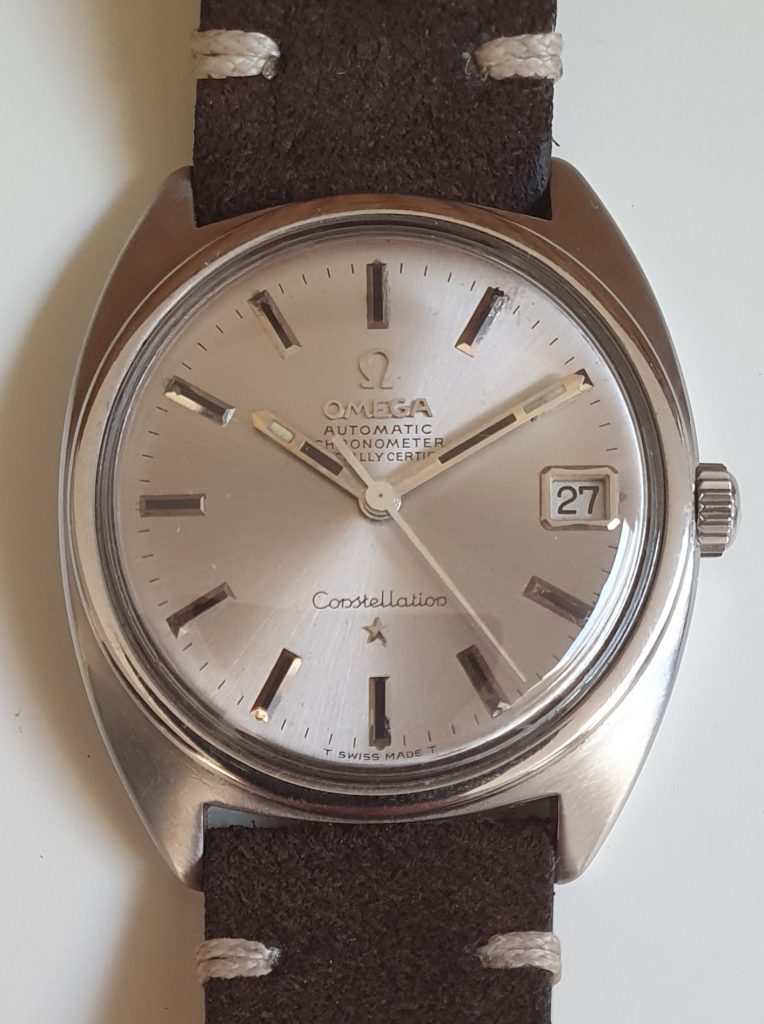| Brand | Omega |
| Model | Constellation, ref. 168.017 |
| Year | 1968 |
| Caliber | Cal. 564 Cal nr. 27170000 |
| Details | Size 36 mm Steel Full service aug 18′ (Urma) |
| Links | Omega Vintage watches Cal 564 repair Great article about |
| Search | dba.dk / “Omega” chrono24 / “Omega” |
A Brief History of the Omega Constellation
The Omega Constellation watch was once the flagship in the Omega collection. This particular family within their collection dates back to 1952 and according to Omega’s Journey Through Time publication (2007) it was because their limited produced Centenary collection was so high in demand by customers. This 1948 Omega Centenary commemorated the 100th birthday of the Omega company and was their first automatic chronometer watch. It wasn’t made in series production but the demand for them was so high, that Omega decided to create a new family of automatic chronometer watches in 1952: The Constellation.
The first Omega Constellation models had bumper movements and distinctive diamond shaped hour markers.
After a few years, around 1955, the Omega calibre 354 bumper movement with chronometer rating was replaced by the calibre 50x series. This movement had a normal rotor and came in several versions (date/no-date). In 1959 this range of movements was succeeded by the calibre 55x (no date) and 56x (date) movement families. Note that some of these movements were also used in Seamaster models, but only in very rare cases they were chronometer certified. One of the best online resources on this topic is the Omega Constellation Collectors blog by Desmond. He also features a nice overview of the different dials and cases that were used in the Constellation collection.
Rich Dials, Fancy Lugs
One of the things that make the Constellation stand out from the other Omega families of that time, is that the dials on these Constellation models were richly decorated. The use of gold dials, gold hour markers, onyx hour markers, gold hands and gold applied logos and wording is something that wasn’t seen on any of their other collections to this extent. Some of the gold dials had a satin-brushed finish, others had a sun-guilloché pattern or a cross-hatched dial. There were many different dials available for the Omega Constellation in the 1950s and 1960s.
The pie-pan dials were commonly used in the vintage Omega Constellation watches. The use of the gold diamond-shaped hour markers is less common and only seen on the earlier models. In the 1960s Omega added the use of the Onyx stick markers on some of the Constellation models. Better said, these are gold hour markers with an Onyx inlay.
Another thing that makes the Constellation attractive to a lot of collectors are those nice fancy lugs. Those early Omega Constellations have rounded lugs and were later a bit more restyled to the 1960s.
Observatory of Geneva
All gold Constellation models have the observatory of Geneva hand-engraved on the back. The stainless steel models and gold/steel models have a (gold) medallion on the back with the observatory of Geneva. Where the dial features this gold star highlighting the model name ‘Constellation’, the case back has the observatory engraved under a starry sky. The eight stars on the case back stand for the many exploits of Omega in the world chronometer competition. The Constellation is always a chronometer watch. A certification that proofs the high accuracy of a movement. Besides the Constellation, some other families of the Omega collection also included watches that had a chronometer rating. However, the vintage Omega Constellation being the flagship of the brand at that time were all rated chronometer.
Great article on the C-shape Constellations
C-Shape-OMega-Constellation// more text to come //
